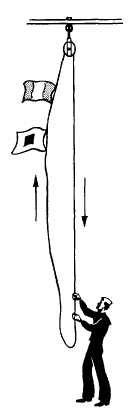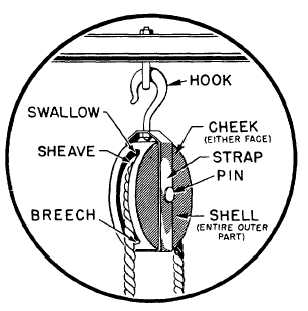CHAPTER 2
BLOCK AND TACKLE
CHAPTER LEARNING OBJECTIVES
Upon completion of this chapter, you should be able to do the following:
l Describe the advantage of block and tackle afloat and ashore
Blocks—pulleys to a landlubber—are simple
machines that have many uses aboard ship, as well as
onshore. Remember how your mouth hung open as you
watched movers taking a piano out of a fourth story
window? The guy on the end of the tackle eased the
piano safely to the sidewalk with a mysterious
arrangement of blocks and ropes. Or, you’ve been in the
country and watched the farmer use a block and tackle
to put hay in a barn. Since old Dobbin or the tractor did
the hauling, there was no need for a fancy arrangement
of ropes and blocks. Incidentally, you’ll often hear the
rope or tackle called the fall, block and tack, or block
and fall.
In the Navy you’ll rig a block and tackle to make
some of your work easier. Learn the names of the parts
of a block. Figure 2-1 will give you a good start on this.
Look at the single block and see some of the ways you
can use it. If you lash a single block to a fixed object-an
overhead, a yardarm, or a bulkhead-you give yourself
the advantage of being able to pull from a convenient
direction. For example, in figure 2-2 you haul up a flag
hoist, but you really pull down. You can do this by
having a single sheaved block made fast to the yardarm.
This makes it possible for you to stand in a convenient
place near the flag bag and do the job. Otherwise you
would have to go aloft, dragging the flag hoist behind
you.
Figure 2-1.-Look it over.
Figure 2-2.-A flag hoist.
2-1



